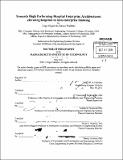Towards high performing hospital enterprise architectures : elevating hospitals to lean enterprise thinking
Author(s)
Fradinho, Jorge Miguel dos Santos
DownloadFull printable version (69.87Mb)
Other Contributors
Massachusetts Institute of Technology. Engineering Systems Division.
Advisor
Deborah J. Nightingale.
Terms of use
Metadata
Show full item recordAbstract
This research is motivated by the National Academy of Engineering and the Institute of Medicine's joint call for research in healthcare, promoting the application of principles, tools, and research from engineering disciplines, and complex systems in particular. In 2005, the US healthcare expenditure represented 16% of its GDP, with hospitals representing the largest source of expenditure, as is the case in the United Kingdom. Consequently, the strategies and operations developed and implemented by hospitals have a significant impact on healthcare. Today, it would be hard to find a hospital that is not implementing a Lean initiative or who isn't familiar with its concepts. However, more often than not, their approach has narrowly focused at a process level and inside individual service units like an emergency department. This research seeks to elevate traditionally narrow hospital definitions of lean and explore the broader concepts of lean enterprise principles and Enterprise Architecture (EA) while enhancing our knowledge of hospitals' socio-technical complexity and enriching an emerging EA Framework (EAF) developed at the Massachusetts Institute of Technology (MIT). Following an extensive longitudinal multidisciplinary literature review, a number of expert interviews, and preliminary empirical findings, an exploratory inductive and deductive hybrid study was designed to collect and concurrently analyze both qualitative and quantitative empirical data from multiple hospital settings over two main phases: * The first phase consisted of recorded interviews with the Chief Executive Officers of seven leading Massachusetts hospitals, who also provided sensitive internal strategy and operations documents. We explored how hospitals currently measure their hospital performance and how their explicit and implicit practices may be improved using lean enterprise principles. e The second phase comprised two in-depth case studies of large leading multidisciplinary hospitals, one located in the US and other in the United Kingdom, and included a total of 13 embedded units of analysis. Multiple sources of evidence were collected including electronic medical records, 54 interviews, observation, and internal documents. Findings were categorized and sorted, as phenomena of interest consistently emerged from the data, and enriched both the EAF, and our understanding of hospitals' EA in particular. In both in-depth hospital cases we found that their EA consisted of multiple internal architectural configurations, and in particular, those with an enriched understanding of EA had made decisions which had improved not only their local performance, but also enhanced their interactions with other service units upstream and downstream. Conversely, worse performing configurations demonstrated a limited understanding of their hospital's EA. We conclude that hospital performance can be improved through an enriched understanding of hospital EA. Furthermore, whilst considering all hospitals included in this study, we propose general and specific recommendations, as well as diagnostic questions, performance dimensions, and metrics, to assist senior hospital leaders in architecting and managing their enterprise.
Description
Thesis (Ph. D.)--Massachusetts Institute of Technology, Engineering Systems Division, 2011. Cataloged from PDF version of thesis. Includes bibliographical references (p. 608-630).
Date issued
2011Department
Massachusetts Institute of Technology. Engineering Systems DivisionPublisher
Massachusetts Institute of Technology
Keywords
Engineering Systems Division.